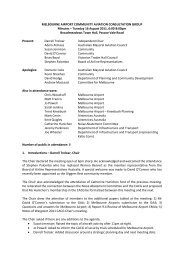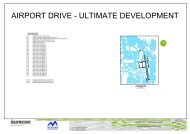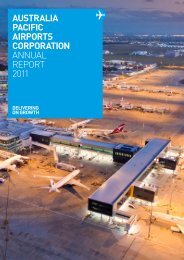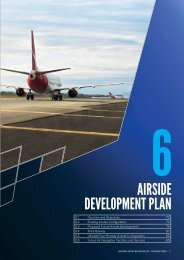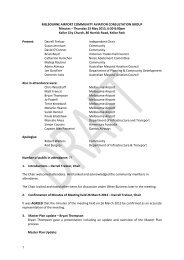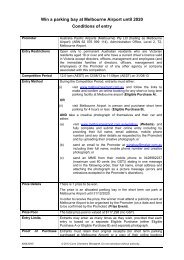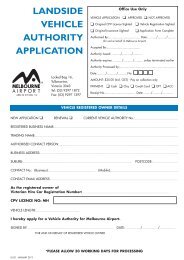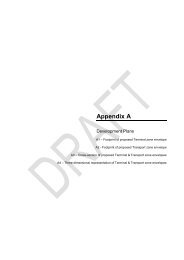Section 9 - Ground Transport Plan - Melbourne Airport
Section 9 - Ground Transport Plan - Melbourne Airport
Section 9 - Ground Transport Plan - Melbourne Airport
Create successful ePaper yourself
Turn your PDF publications into a flip-book with our unique Google optimized e-Paper software.
9.5.1 Internal Roads<br />
The elevated loop road and the accompanying connections<br />
to the existing roads and transport hubs is the critical<br />
piece of infrastructure that will shape the internal road<br />
network. As a matter of priority, work will commence on<br />
designing and implementing the elevated loop road. Given<br />
the scale of the project, valued at over $300 million, the<br />
new road will be built in stages. The first stage (subject to<br />
approval) is programmed to start in 2014–2015 and will<br />
target the existing intersections that cause the congestion<br />
to and from the airport and the Tullamarine Freeway.<br />
Francis Briggs Road is being extended south from APAC<br />
Drive to connect to Melrose Drive at the Mercer Drive<br />
intersection. This will provide dedicated access for taxis<br />
from the primary taxi-holding area. It will enable the<br />
airport to maintain response time for passengers and<br />
surety for the necessary taxi response times in the<br />
terminal precincts. The road will also provide access to<br />
the new Airside Gate (27) to service the logistics supply<br />
to the commercial sites in the Airside Precinct. Francis<br />
Briggs Road will also allow access to the taxi-holding<br />
area and relocated staff car park, providing additional<br />
capacity on Melrose Drive by removing congestion<br />
arising out of the previous vehicle entries and exits.<br />
Melrose Drive will enjoy the benefit of the duplication<br />
of the final section just east of Centre Road. This will<br />
reinforce access into the Southern Precinct Terminal<br />
area and to the freight precinct.<br />
Terminal Drive will also benefit from an additional lane<br />
and improvements to the intersection with Centre Road,<br />
which will help with capacity until the elevated loop road<br />
is built.<br />
The <strong>Airport</strong> Drive extension will complete the approach<br />
to the airport from the M80 Ring Road. The <strong>Airport</strong> Drive<br />
extension will provide a secondary entry point into the<br />
airport precinct and relieve some of the congestion on<br />
the Tullamarine Freeway and the amount of airport traffic<br />
using Melrose Drive. The <strong>Airport</strong> Drive extension will<br />
consist of a four-lane divided road (two lanes in each<br />
direction), with the provision to expand to six lanes at<br />
a later time.<br />
The existing section of <strong>Airport</strong> Drive between the M80<br />
Ring Road and Sharps Road is currently a four-lane<br />
divided road managed by VicRoads. It is understood<br />
there are no current plans for that section to be widened,<br />
noting that there are physical constraints that may impact<br />
that possibility.<br />
9.5.2 <strong>Melbourne</strong> <strong>Airport</strong> Forecourt<br />
Development<br />
The growth of the internal road network will improve<br />
capacity within the airport. However, there is an equally<br />
important need to maintain a corresponding capability<br />
for passenger drop-off and pick-up within terminal<br />
precincts. The main forecourt precinct underwent major<br />
renovation during 2011, 2012 and 2013 that has involved<br />
creating additional traffic lanes for drop-off and pick-up<br />
in front of the T1, T2 and T3 terminals, and streamlining<br />
the use of the area for the various modes of transport<br />
including taxis, bus services and general private vehicles.<br />
Work continues to improve the precinct’s amenity, safety<br />
and security.<br />
DRAFT<br />
Equally important is the Southern Precinct Program.<br />
<strong>Plan</strong>ning is underway to separate pedestrians and<br />
vehicles and provide high capacity access to and from<br />
the road network by developing a ground transport hub.<br />
This facility will work in harmony with the elevated loop<br />
road to minimise, if not eliminate, congestion for the life<br />
of this Master <strong>Plan</strong>.<br />
9.5.3 External Roads<br />
Reliable and efficient transport links between <strong>Melbourne</strong><br />
<strong>Airport</strong>, the CBD and the metropolitan area are critical<br />
to ensure there are appropriate levels of access to the<br />
state’s major airport. Currently 80 per cent of all vehicles<br />
accessing the airport use Tullamarine Freeway. Given the<br />
reliance on this arterial road, and the current congestion<br />
levels that occur, <strong>Melbourne</strong> <strong>Airport</strong> believes the State<br />
Government must consider widening the Tullamarine<br />
Freeway as a matter of priority, particularly the section<br />
that continues to impact airport-bound traffic.<br />
126




